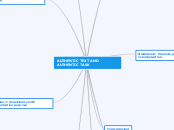AUTHENTIC TEXT AND AUTHENTIC TASK
Task Typologies
Task Taxonomies
Communicative approach
Language and practise language skills
Process
Extracting information
Drawing inferes
MAking calculation
Interpreting and extrapolating
Analysis
Extension
Reformulation
process
outcome
SAMPLES
Task design
task
listing
ordening
Sorting
Comparing
Problem-solving
Sharing personal Experiences
Creative task
Guideline 6: Promote purposeful communication.
Communicative roots
communicative
Methodological implementation
Communicative competence
Classic activities
Listening and audio
Aspect of creativity
Outcome
Communications tecnology
Task real communication
language
culture
Topic principal
Guideline 5: Exploit learners'existing knowledge.
Exploiting of the learner
cultural
New task/text
Class-teacher led activities
Deployment prior Knowledge
Idiomatic Lenguage
Linguistic
Language level
Language concepts
Encourarating , motivating
and provide incent for the new task
Language learning task
Designing materials
Individual learners group
Language structures a group
Fatual thing
Daily and Leisure
Levels of social structures
New concepts
Guideline 4: Approximate real life- tasks
Native Speaker task
Native Speaker Activities
Adjusting a plan on the basis
Listening and reading
Learning task
Particular professional context
Internal experience
Amount information
non-verbal sign
Native speaker React
Deals with given piece of textt
TASK
Pedagogical model
communicative approach
to lenguage teaching
Pre-task
whole class activity,
teacher guidance and control.
the task
individual or voluntary
collaborative work
assessment
Task outcome,
individual students'of task outcome
TOWARDS A FRAMEWORK FOR TASK AUTHENTICY
Authentic text for language learning
ELT Coursebooks
Resources books
Pedogical task
psychological terrain
criteria for task authenticity
methodology and curriculum planing
Teaching materials
language skills
Development estrategies
Classroom task
Learners needs
Learning task
Learning context
Real-life style task
Practical implementation
Literature on materials development
Guideline 1: Consistency with communicative purpose
Communicative purpose
Materials development
Mantein social relationship
Literature rational, Listeners and readers
Three basic categories
Category Suasion
advising, ordering,
warning , threating and permitting
Physical action
Category Personal Emotion
Pleasure and Displasure
Intellectual response
Category Emotive relations
Expresing sympathy or gratitude
Aproductive reaction
One transactional,
informative and persuasive
Interactional
interactive and provocative
Reactive
Engaging, reational
passive reception text
transmite information
persuade
soliciting
instructional
provocative
interactive
engaging
Basic communicative funtion
Transactional
Interactional
Reactional
GUIDELINES2 AND 3: Appropriacy, response and engagement
Texts presupposes
Learner
Anticipated reaction
Text
Level engagement
Language pedagoggy
Linguistic comprehension
Learning task
Task designer
Language teacher
As Native Speaker
Listener
Attention to musical or
visual elements
Reader
Relationship or actitude to text
Learner
Points out activities
Avoided or sensitive
to the text and Emotional Potential
